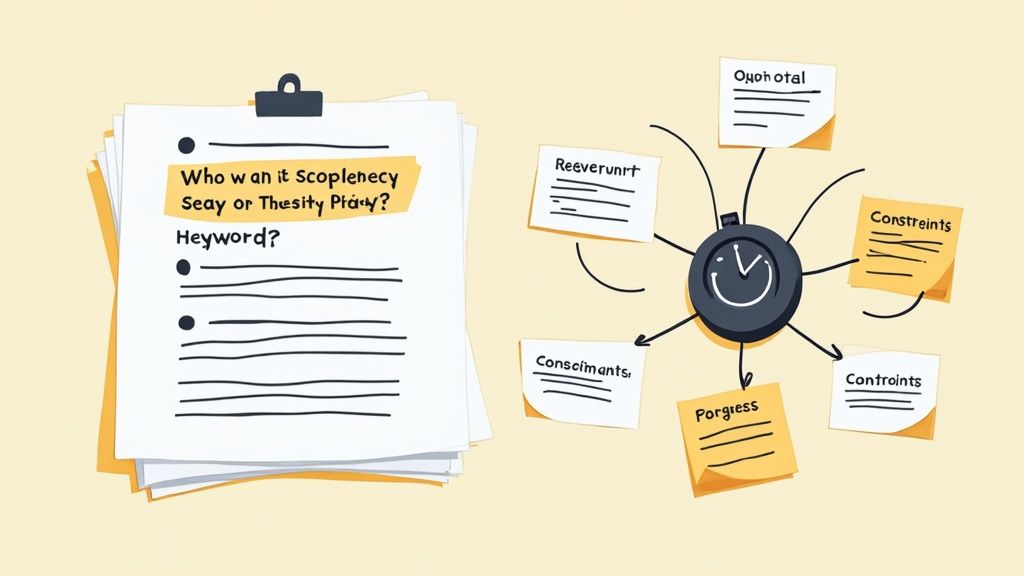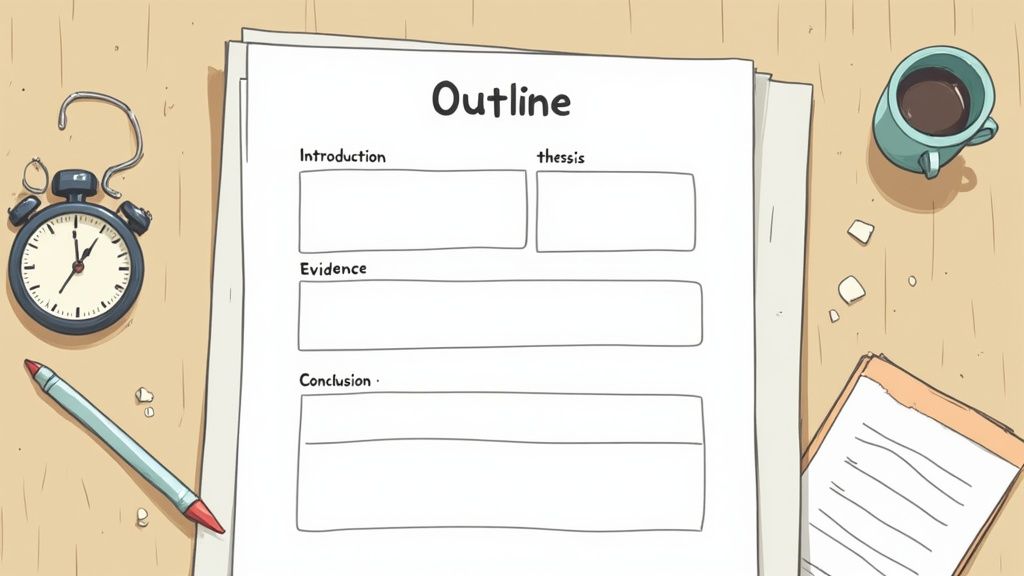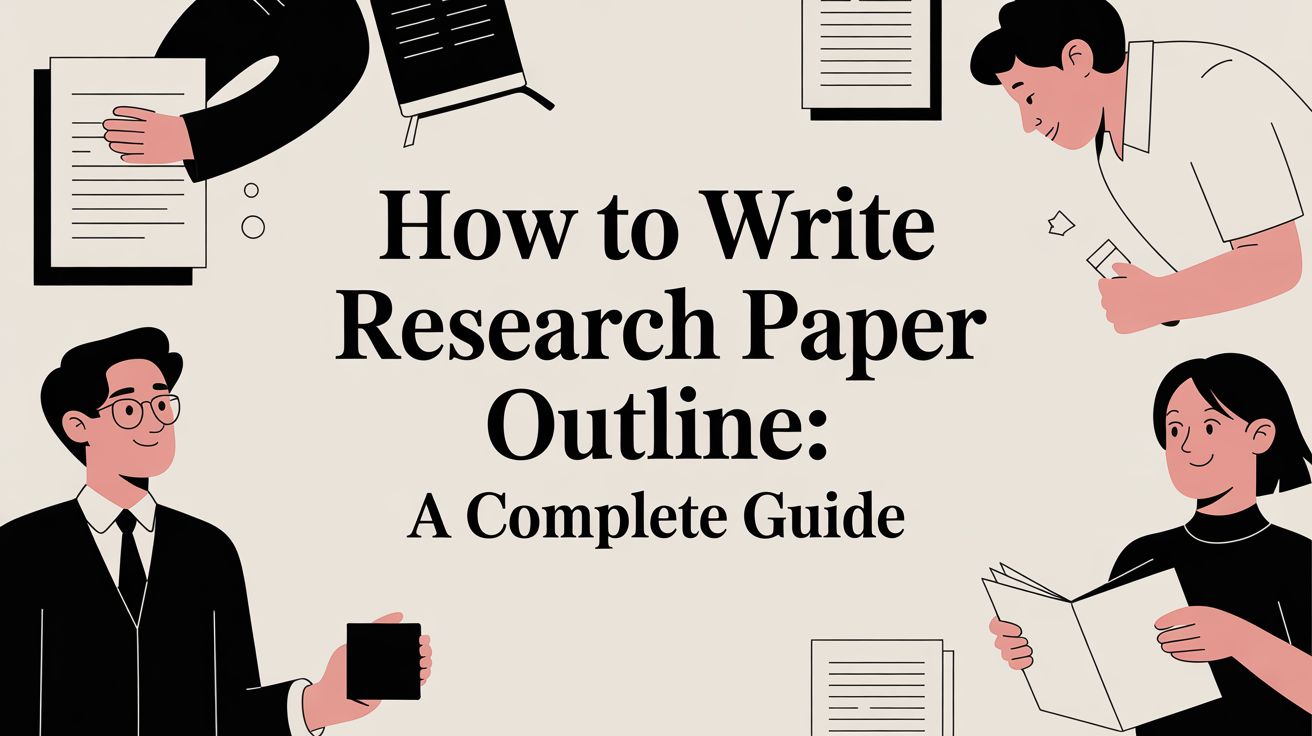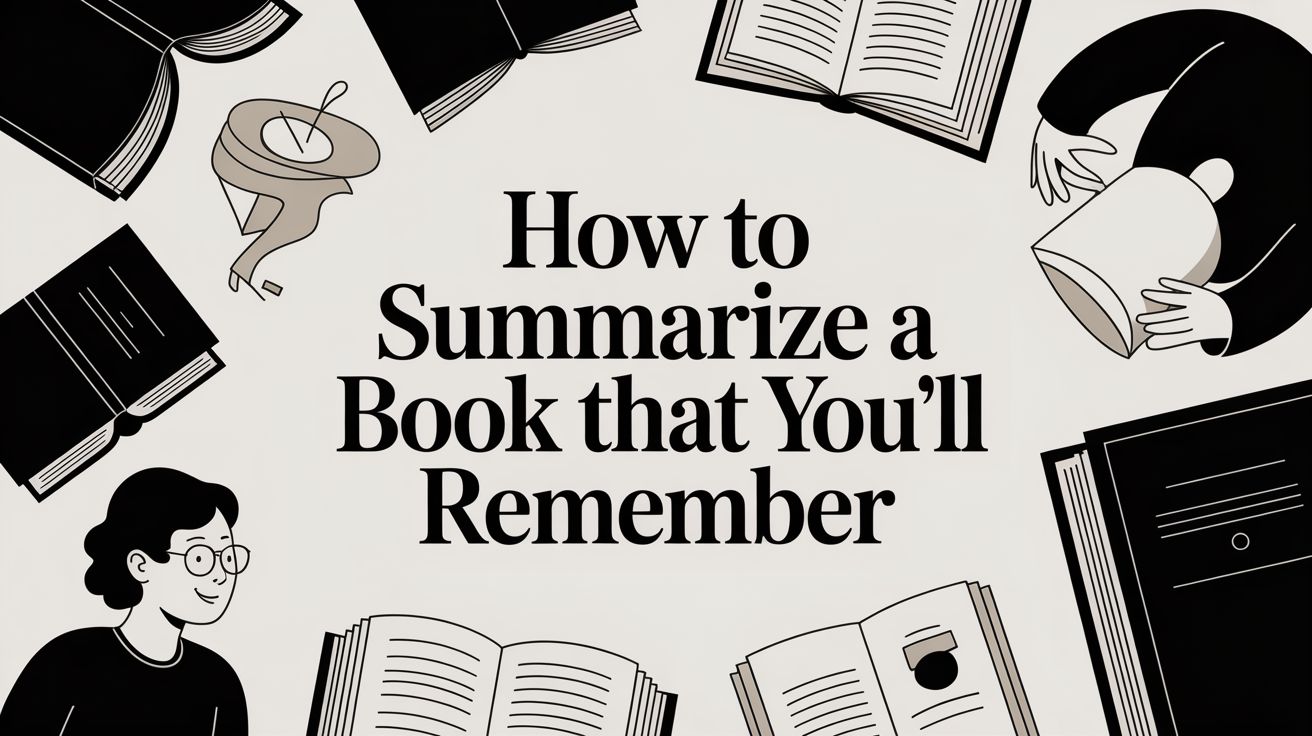How to write essay fast: Finish Quickly and Get a Grade
How to write essay fast: Master quick research, outlining, and drafting to beat deadlines with a strong grade

Writing a quality essay fast isn't about magic; it's about method. The secret lies in a simple, structured process: break down the prompt, research with purpose, build a solid outline, write in focused bursts, and finish with a targeted edit. This time-boxed approach turns that overwhelming feeling of "where do I even start?" into a series of clear, manageable steps.
A Practical Framework for Writing Essays on a Deadline
We've all been there—staring at a blank page, the deadline looming, and the cursor just blinking. Mocking you. The anxiety is real, but the answer isn't to type like a maniac or hope for a sudden jolt of inspiration. The key to writing an essay quickly is to adopt a smarter workflow. It’s a system, not a miracle, and it’s all about doing the heavy lifting (the thinking) upfront so the actual writing flows smoothly.
This guide lays out that exact system. We're going to walk through a practical, step-by-step framework that will get you from prompt to polished paper, minus the usual panic. The whole idea is to assign strict time limits to each stage. This prevents you from getting bogged down in any one area, like falling down a research rabbit hole for hours on end. So, forget the classic advice to "just start writing." A few minutes of planning will save you hours of painful rewriting later.
The Three Pillars of Speed Writing
This visual really captures the essence of the process, breaking it down into three core phases: planning, writing, and editing.

Each of these stages is essential for building momentum and making sure your final essay is coherent, well-argued, and actually answers the prompt.
The pressure to produce good work quickly is immense, and it has created a huge market. The global essay writing service industry was valued at roughly $1.97 billion in 2023 and is projected to more than double by 2032. This isn't just a random statistic; it highlights the intense academic pressure students face. It's no wonder that tools like ChatGPT are now used by 26% of American teens for schoolwork. You can dig into more of these trends and find more insights on the essay writing market over on Dataintelo.com.
The real bottleneck in essay writing isn’t typing speed—it’s thinking speed. A structured approach clears the mental clutter, allowing you to focus on articulating your argument clearly and efficiently.
This guide offers a battle-tested method that goes way beyond generic tips. You'll learn specific, actionable techniques for every step of the way:
- Prompt Analysis: How to instantly pinpoint the core question and any hidden constraints.
- Targeted Research: Find credible sources fast without getting lost in endless articles.
- Power Outlining: Create a detailed blueprint that turns drafting into a simple connect-the-dots exercise.
- Focused Drafting: Use simple but effective techniques like the Pomodoro method to write in productive sprints.
- Efficient Editing: Polish your work with a strategic checklist instead of just rereading it over and over.
Master this system, and you'll be able to produce solid essays consistently, without that all-too-familiar, last-minute dread.
The Time-Boxed Essay Method At a Glance
Here’s a practical breakdown of how to allocate your time for maximum efficiency when writing an essay under pressure.
| Stage | Time Allotment | Primary Goal |
|---|---|---|
| 1. Analyze the Prompt | 5-10 Minutes | Understand the core question, keywords, and constraints. |
| 2. Rapid Research | 30-45 Minutes | Gather key quotes, facts, and supporting evidence. |
| 3. Power Outline | 10-20 Minutes | Create a detailed structural map for the entire essay. |
| 4. Focused Drafting | 60-90 Minutes | Write the full draft, focusing on flow and content, not perfection. |
| 5. Strategic Revision | 20-30 Minutes | Edit for clarity, argument, grammar, and citations. |
Think of this table not as a rigid rulebook, but as a flexible guide. The goal is to instill discipline and prevent any single stage from derailing your progress.
Deconstruct Your Prompt and Brainstorm with Purpose
The first 30 minutes are make-or-break when you're racing the clock. Before you even think about opening a new document, you have to get to the heart of the assignment. I've seen it a hundred times: students rush this part and end up wasting hours on painful rewrites. Don't be that student.
Think of the essay prompt as a puzzle. Read it once to get the gist. Then, read it again, but this time, grab a highlighter or pen. Your job is to pull out the core components of the question.
Pinpoint the Core Directives
Every prompt has action verbs that are basically your marching orders. These are the words that tell you exactly what the professor wants you to do. Look for words like "analyze," "compare," "evaluate," or "discuss." They aren't just suggestions; they're commands.
For instance, a prompt asking you to analyze the economic impact of a historical event is a totally different beast than one asking you to summarize it. Analysis means you're breaking the topic down and showing how the pieces fit together. A summary is just a quick flyover. Getting that one word wrong can send your entire essay off a cliff.
- Analyze: Take it apart. Show how the components work together.
- Compare and Contrast: Point out what’s similar and what’s different.
- Evaluate: Judge its value or effectiveness and back up your judgment with evidence.
- Argue: Pick a side on a debatable issue and defend your position like a lawyer.
Nailing these verbs right away clarifies your mission and saves you a world of trouble.
Master Rapid Idea Generation
Okay, you know what you need to do. Now you need ideas, and you need them fast. Don't just sit there waiting for a lightning bolt of inspiration—it’s not coming. You have to force the ideas out with a structured technique.
One of the best ways to do this is a quick-and-dirty mind map.
Set a timer for 10 minutes. Seriously, just ten. Write your main topic in the center of a page and start branching out with anything and everything that pops into your head. Don't filter, don't judge. At this stage, quantity is everything. This visual approach often reveals connections you wouldn't spot in a simple list, and sometimes a solid thesis statement just emerges from the chaos.
A huge mistake I see is treating brainstorming like a passive waiting game. You have to be aggressive. Timed, focused brainstorming forces you to engage with the material from minute one, building the momentum you need to carry you through the entire process.
Another great trick is the "Question Burst." Spend five minutes just writing down every single question you can think of about the prompt. What is the prompt assuming? Are there any undefined terms? Who are the key players or ideas? This little exercise can uncover unique angles and gives you a much clearer path for your research and, ultimately, a faster drafting phase.
Mastering Speed Research and Source Management
Let's be honest, research can feel like a bottomless pit. You start looking for one thing, and three hours later you've read twenty articles and somehow ended up on a Wikipedia page about the history of garden gnomes. To write an essay fast, you can't afford that. You have to treat research like a surgical strike, not an aimless wander.
The mission is to get in, grab the evidence you need, and get out. I recommend setting a hard limit: give yourself just 60-90 minutes for this entire phase.
It all starts with the right keywords. Generic searches like "World War II" are a waste of time. Instead, pull specific, targeted phrases directly from your prompt analysis. Think more along the lines of "economic impact of rationing on British civilians WWII" or "long-term effects of the Treaty of Versailles." Sharp, focused queries are your best weapon against information overload.
Find Credible Sources Instantly
Your best friends for this mission are academic databases. Your university library likely gives you access to giants like JSTOR or ProQuest, but my go-to for speed is always Google Scholar. It cuts through the internet junk and serves up peer-reviewed articles, books, and papers—exactly the kind of stuff professors love to see.
Just look at what happens with a specific search. It immediately gives you targeted, academic results.

You can see citation counts, find related articles, and check different versions, all from one screen. This is a world away from a standard Google search and built for academic efficiency.
Once you have a results list, you need to vet sources on the fly. Don't even think about reading entire articles right now. Instead, live by the "Abstract First" rule. The abstract is that short summary at the start of every academic paper, and it’s your best friend. It lays out the article's purpose, methods, and main findings. In about 90 seconds, you can tell if it's a goldmine or a dead end. If it’s not a fit, move on. No guilt.
Extracting Information with Precision
Okay, so you've found a promising abstract. Your next move is what I call the "CTRL+F Method." Open the full-text PDF and use the find function (CTRL+F on Windows, CMD+F on Mac) to search for your keywords. This lets you jump straight to the juicy parts, bypassing pages of dense academic jargon. Remember, you’re not reading for pleasure; you’re hunting for evidence.
As you find those golden nuggets—a killer statistic, a powerful quote, a key piece of data—don't just bookmark the article. Immediately copy and paste the relevant snippet into a separate "Quick-Quote Bank" document.
Pro Tip: The single biggest time-saver you can adopt is capturing citations as you research. Create a simple running list. For each entry, paste the quote or data, then add the author, the page number, and the source link. This one habit completely eliminates that last-minute panic of trying to find where you got everything.
This document becomes your arsenal. It’s a pre-organized collection of evidence ready to be deployed as you write. A simple system like this turns research from a frustrating chore into a solid foundation for getting your essay done, fast.
Building a Powerful Outline in Under 20 Minutes
I get it. When the clock is ticking, skipping the outline feels like a smart shortcut. It’s the single biggest mistake you can make.
Trust me, you aren't saving time. You're just pushing the hard thinking into the drafting phase, which leads to dead ends, painful rewrites, and a much slower process. A solid outline, built in just 15-20 minutes, is the blueprint for your entire essay. It's your secret weapon for speed.
This isn't just about a few random bullet points. It's about creating a detailed map that guides every paragraph. By forcing yourself to structure the entire argument upfront, the actual writing becomes more like a "connect-the-dots" game. The real bottleneck in academic writing isn’t how fast you can type; it's how fast you can think and organize your ideas. A good outline solves that problem before you even start writing.
The Power Outline Template
Think of your outline as a "fill-in-the-blanks" framework. For every single body paragraph, you need to lock in three key pieces of information. This simple structure is non-negotiable—it guarantees that every paragraph has a clear purpose and stops you from rambling.
For each body paragraph, write down these three things:
- Topic Sentence: Pinpoint the single sentence that will open the paragraph and state its main idea. This is your anchor.
- Key Evidence: Identify the specific quote, statistic, or piece of data you'll use to back up your point. Pull this straight from your "Quick-Quote Bank."
- Brief Analysis: Add a short note—just one sentence is fine—explaining how that evidence proves your topic sentence. This is your "so what?" and it's what separates a C-grade essay from an A-grade one.
This little system takes your jumbled thoughts and forges them into a logical, persuasive argument. It builds momentum and ensures you start with absolute clarity.
A well-planned essay doesn’t just help you write faster—it helps your instructor read and mark it faster. The logic is clearer, the argument is focused, and your key points are impossible to miss.
Putting It Into Practice
Let's say you're writing an argumentative essay on the impact of remote work on employee productivity. A small section of your power outline might look something like this:
Body Paragraph 2
- Topic Sentence: While autonomy can increase job satisfaction, it also introduces significant risks of burnout without structured oversight.
- Key Evidence: Use the Smith (2023) study showing a 40% increase in self-reported burnout among fully remote employees.
- Brief Analysis: This data shows that the lack of physical separation between work and home life directly contributes to overwork, challenging the idea that remote work is universally beneficial for well-being.
See how that works? With this much detail, drafting the actual paragraph is a breeze. You’ve already done the heavy lifting. All that's left is to flesh out these points into complete sentences, and you'll have a coherent, well-supported essay in no time.
Drafting Like a Machine with Focused Writing Sprints

Okay, you've got your outline. This is where the magic happens. Your job now is to shift from architect to builder and get that raw material onto the page. The key is to stop thinking about writing a whole essay, which is intimidating, and instead focus on short, intense bursts of pure writing.
This is where a technique like the Pomodoro Technique absolutely shines. I swear by this method when I'm on a tight deadline. You set a timer for 25 minutes and just write. No distractions, no second-guessing. After the timer goes off, you take a five-minute break. It’s that simple. The short time frame forces you to get words down without getting lost in the weeds or burning out.
Embrace the "Write First, Edit Later" Mentality
This is probably the single biggest piece of advice I can give you for the drafting stage: writing and editing are two different jobs. Trying to do both at the same time is a recipe for disaster. It’s like trying to drive a car and fix the engine simultaneously. You won’t get very far.
Your inner critic will scream at you, but you have to ignore it. Give yourself permission to write a terrible first draft. It can be messy. It can be clunky. That's perfectly fine. A messy draft is something you can work with; a blank page is not.
The real bottleneck isn't how fast you type—it's how fast you can think. When you work from a detailed outline, you've already done the heavy lifting. You've solved the "what do I say next?" problem, so all that's left is to just say it.
This is how you build momentum. You tackle one paragraph at a time, trusting the roadmap you’ve already created in your outline.
Using Simple Templates for Speed
To really crank up the speed during those writing sprints, lean on simple paragraph structures. This isn't about being robotic; it's about being efficient. You remove the friction of figuring out how to structure each paragraph, which lets you focus on the content.
Here are a few back-of-the-napkin templates I use:
- The Introduction: Start with a hook to grab the reader. Add 2-3 sentences of background context. Then, drop your one-sentence thesis statement. Done.
- Body Paragraphs (PEA Method): This is a classic for a reason. Make your Point in the topic sentence. Back it up with Evidence (a quote, data, an example). Then, Analyze it—explain why that evidence proves your point.
- The Conclusion: Start by restating your thesis in a fresh way (don't just copy-paste it). Briefly summarize your main arguments. Finish with a final thought that speaks to the broader importance of your topic.
Combining these simple structures with focused sprints turns a marathon of a task into a series of manageable little jogs. It’s a system built for getting a solid draft done fast.
Editing and Citing with a No-Nonsense Checklist

This final stage is what separates an okay essay from a great one. But when the clock is ticking, you can't afford to get lost in aimless rereading. The trick is to use a structured, multi-pass editing strategy that gets the job done right. Forget perfection—think of this as a focused 30-45 minute checklist.
Your first pass is all about the big picture. Seriously, read your essay out loud. This simple trick forces you to slow down and immediately exposes awkward sentences and weird logical jumps your eyes would skim right over. Don't sweat the typos just yet. Just ask yourself: Does my argument actually make sense? Is the thesis holding up from start to finish?
Once you’re happy with the flow, it's time for a second pass. This is your fine-tooth comb review. Now you can obsess over grammar, spelling, and punctuation. Thankfully, you don't have to do it alone.
Smart Tools for a Quick Polish
Automated tools are an absolute lifesaver here. They act as a reliable second pair of eyes, catching the common mistakes you’re guaranteed to miss when you're tired and rushing.
- Grammar and Spelling: A tool like Grammarly is non-negotiable for catching everything from simple typos to those tricky comma splices. The free version is more than enough for a solid final check.
- Clarity and Style: The Hemingway App is another gem. It flags sentences that are too long or dense, helping you sharpen your writing so it’s direct and powerful.
This is exactly how many students are getting ahead. The global essay writing service market, already valued at an estimated $1.8 billion, is projected to reach $2.3 billion by 2026. What’s driving this? A smart hybrid approach. Students use AI and grammar checkers to handle the grunt work of drafting and proofreading—which can slash writing time by 50% or more—and then add their own critical thinking and final polish. You can actually explore more market insights on cognitivemarketresearch.com to see how this trend is shaping academic work.
The goal isn’t some flawless literary masterpiece. It’s a clear, coherent, and polished essay that nails the prompt. A good checklist gets you there fast, stopping you from over-editing or, worse, missing critical errors.
Making Citations Painless
Let's be honest, citations are usually the most tedious part of the whole process. But they don't have to be a last-minute scramble. The secret is managing them as you go.
Start using a citation manager like Zotero or even the built-in reference tools in Microsoft Word or Google Docs. It's a game-changer. Every time you find a source during your research, just drop it into your manager.
When your draft is complete, these tools will generate a perfectly formatted bibliography in whatever style you need (MLA, APA, Chicago) with just a couple of clicks. What used to be a multi-hour headache becomes a two-minute task. It’s that easy.
Common Questions About Speed-Writing Essays
When you're up against the clock, a few nagging questions always seem to pop up. It's totally normal to worry that writing fast means your grade will suffer. Let's tackle some of those common concerns head-on.
Is It Really Possible to Write a Good Essay Quickly?
Yes, it absolutely is. But there’s a catch: it's about being strategic, not just typing faster. The secret lies in compartmentalizing your work. Instead of trying to do everything at once, you dedicate specific, focused blocks of time to each stage—planning, then research, then writing. This is how you build a strong, coherent argument without getting overwhelmed.
There's this myth that a truly great essay requires days of agonizing, slow-burn effort. The truth? A sharp, structured approach often beats long, rambling work sessions. I've seen it time and again: one hyper-focused hour with a solid plan can achieve more than five hours of just "winging it."
But What if I Get Writer’s Block?
Ah, the dreaded blinking cursor. Here's a little secret from experience: writer's block is almost never about having no ideas. It’s a symptom of not knowing what comes next. If you feel stuck, stop trying to force the words out. The problem isn't your writing; it's your plan.
Go back to your outline.
The most effective antidote to writer's block isn't more brainstorming—it's a better outline. Think of it as your GPS. It tells you exactly where to turn next, so you don't have to navigate and drive at the same time.
Take a look at your topic sentences and the supporting points you’ve lined up. Usually, the issue isn't the paragraph you’re currently on, but a weak connection or fuzzy point earlier in your argument. Spending five minutes shoring up your outline is always a faster fix than trying to write your way through the confusion.
When you’re struggling to make sense of a tricky topic or just need to get your thoughts organized, Feen AI can be a lifesaver. Our AI homework helper can give you clear explanations or turn your rough ideas into a well-structured draft in minutes. It's a great way to make your study time count. Get unstuck and power through your assignments at https://feen.ai.
Relevant articles
Learn how to write research paper outline with our guide. Discover formats, structures, and revision tips to build a strong academic blueprint.
Discover the best good transition words for conclusions to elevate your essays. Our guide offers examples, tips, and templates to make your writing stand out.
How to write a good essay introduction: learn proven techniques to hook readers, set context, and craft a strong thesis
Learn how to summarize a book with our guide for students. Master practical note-taking and writing techniques to capture the core ideas of any text.



